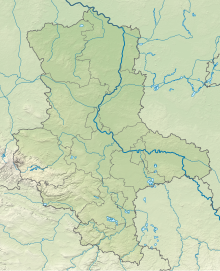Pfaffenheide-Wörpen Bach
Coordinates: 51 ° 54 ′ 31 ″ N , 12 ° 28 ′ 28 ″ E
Pfaffenheide-Wörpener Bach is a nature reserve in the town of Coswig (Anhalt) in the Wittenberg district in Saxony-Anhalt .
The nature reserve with the registration number NSG 0174 is around 484 hectares . It is congruent with the FFH area "Pfaffenheide-Wörpener Bach north of Coswig" and is largely surrounded by the landscape protection area "Roßlauer Vorfläming". The area has been under protection since the end of 1997 (date of regulation: December 22, 1997). The responsible lower nature conservation authority is the Wittenberg district.
The nature reserve is located directly north of Coswig (Anhalt) in the Fläming Nature Park . It protects a mixed oak forest complex and the valley of the Wörpener Bach in a moraine landscape shaped by the Saale glacial period . The forest communities are dominated by oak and hornbeam forests . In the herbaceous layer settle Maianthemum bifolium , Nestwurz , Solomon's seal , Turk's cap , Carex hirta , Mercurialis perennis , Small Meadow Rue , wood bedstraw , Breitblättriger Sitter , bears pod , Carex sylvatica , Lungwort , Sweet Spurge , spiked devil's claw , liverwort , Nick Perlgras and cephalanthera longifolia . This has its most individual occurrence in Central Germany. In places there are also coniferous forests with pine and larch. Here, the herbaceous layer is especially easy to swampy locations Lycopodium clavatum , bell heather , moss eye , Birngrün , Grünblütigem wintergreen and 's Small wintergreen formed.
Along the Wörpener Bach, the bottom of which consists mainly of sand, alder bruchwald and Winkelseggen-Eschenwald grow . In places, mostly fallow grassland can be found. On moist locations, moist herbaceous perennials develop with populations of broad-leaved orchid that are rich in individuals . Meadowsweet , swamp cork's beak , wild angelica and brook avens also settle here . Live in the stream a. Brown lamprey , brown trout and brook loach . The lowlands and small bodies of water are the habitat of common frogs , moor frogs and, more rarely, pond frogs and common toads . Kingfisher and gray wagtail breed by the stream . Various mayflies , stone flies and caddis flies as well as the European Bachhaft find a habitat here.
The nature reserve is largely surrounded by other forests. In the south-west and north-east it also borders on agricultural land . In the west the nature reserve borders on the federal highway 107 , in the southeast a district road runs through the nature reserve. The Coswig bypass planned as the B 187n would cross the nature reserve in the extreme southwest. Various forest paths in the nature reserve are also used as hiking trails.
Web links
Individual evidence
- ^ A b Henrik Klemm: Proud of the Coswiger Knabenkraut , Mitteldeutsche Zeitung , June 3, 2013. Retrieved October 12, 2015.
- ↑ a b Uwe Zuppke, Iris Elz: The Land of Rummeln, Sölle and Erratic boulders: Nature and landscape of the Fläming near Lutherstadt Wittenberg.
- ^ Coswig bypass . Retrieved May 22, 2019.
- ↑ 27 years and no end: bypass for Coswig , MDR , November 21, 2018. Retrieved May 22, 2019.


